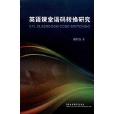《英語課堂語碼轉換研究》由姚明發編寫,是對英語課堂話語中語碼轉換的研究,對語碼轉換適用的態度、語碼轉換話語的結構極其使用的功能進行了深入的探討。《英語課堂語碼轉換研究》結構緊湊,邏輯合理,語料厚重翔實,觀點新穎。
基本介紹
- 書名:英語課堂語碼轉換研究
- 作者:姚明發
- 出版日期:2012年2月1日
- 語種:簡體中文, 英語
- ISBN:9787513514224
- 外文名:EFL CLASSROOM CODE-SWITCHING
- 出版社:外語教學與研究出版社
- 頁數:271頁
- 開本:16
- 定價:61.90
內容簡介,圖書目錄,
內容簡介
《英語課堂語碼轉換研究》由外語教學與研究出版社出版。
圖書目錄
1 Introduction
1.1 Defining code—switching
1.2 Rationale of the research
1.3 Problems and assumptions
1.4 Organization of this book
2 Literature review
2.1 Major distinctions in code—switching research
2.1.1 Code—switching, borrowing and inter—language
2.1.2 Bilingualism and bilinguals
2.1.3 Speech community and classroom community
2.2 Approaches in code—switching research
2.2.1 Linguistic approach to code—switching
2.2.2 Psycholinguistic approach to code—switching
2.2.3 Conversation analytical approach to
code—switching
2.2.4 Sociolinguistic approach to code—switching
2.3 Studies on code—switching in classroom discourse
2.3.1 Studies on code—switching in FL/SL classroom
2.3.2 Studies on code—switching in bilingual classrooms
2.4 Summary
3 Methods and procedures
3.1 Introduction
3.2 Research questions
3.3 Research sites and subjects description
3.3.1 Introduction
3.3.2 Two key schools
3.3.3 Sampling classes and subjects
3.4 Data collection
3.4.1 Observing classes
3.4.2 Recording the classes
3.4.3 Interviewing the teachers
3.4.4 Administering questionnaires
3.5 Data analysis
3.5.1 Transcribing and coding
3.5.2 Quantitative analysis
3.5.3 Qualitative analysis
3.6 Summary
4 Attitudes to code—switching
4.1 Introduction
4.2 Teachers' attitudes to code—switching
4.2.1 Attitudes to CS in relation to teachers' persona
4.2.2 Attitudes to CS in relation to subject access
4.2.3 Attitudes to CS in relation to classroom
management
4.2.4 Attitudes to CS in relation to interpersonal
relations
4.3 Participant and non—participant teachers' attitudes
4.4 Students' attitudes to code—switching
4.4.1 Attitudes to CS in relation to teachers' persona
4.4.2 Attitudes to CS in relation to subject access
4.4.3 Attitudes to CS in relation to classroom
management
4.4.4 Attitudes to CS in relation to interpersonal
relations
4.5 Different attitudes to CS between teachers and
students
4.6 Summary
5 Major patterns of code—switching
5.1 Structural patterns of code—switching
5.1.1 Switching at the word (or phrase) level
5.1.2 Switching at the clause level
5.1.3 Structural properties of teachers' code—switching
5.1.4 Discussion
5.2 Language choices in teacher talk
5.2.1 Utterances used by teachers and students
5.2.2 Teachers' language distribution
5.2.3 Distribution of function types
5.2.4 Three types of code—switching
4.2.5 Code—switching types, unit types and function
5.2.6 Discussion
5.3 Discourse markers as triggers to language alternation
5.3.1 Functions of major discourse markers
5.3.2 Discussion
5.4 Summary
6 Major functions of code—switching
6.1 Code—switching for subject access
6.1.1 Code—switching for lexis or grammar explanation
6.1.2 Code—switching for eliciting responses
6.1.3 Code—switching for clarifying the content
6.1.4 Code—switching for repetitive
6.2 Code—switching for classroom management
6.4 Code—switching as a strategy in communication
6.5 Discussion
6.6 Summary
Conclusion
7.1 Introduction
7.2 Summary of the research
7.3 Contributions of the current research
7.4 Limitations of the research
7.5 Directions for future studies
Bibliography
Appendix 1 : Survey
Appendix 2: Teacher interview
Appendix 3 : Transcription conventions
Appendix 4
Appendix 5 : Attitudes to teachers' CS by percentage
Acknowledgements
1.1 Defining code—switching
1.2 Rationale of the research
1.3 Problems and assumptions
1.4 Organization of this book
2 Literature review
2.1 Major distinctions in code—switching research
2.1.1 Code—switching, borrowing and inter—language
2.1.2 Bilingualism and bilinguals
2.1.3 Speech community and classroom community
2.2 Approaches in code—switching research
2.2.1 Linguistic approach to code—switching
2.2.2 Psycholinguistic approach to code—switching
2.2.3 Conversation analytical approach to
code—switching
2.2.4 Sociolinguistic approach to code—switching
2.3 Studies on code—switching in classroom discourse
2.3.1 Studies on code—switching in FL/SL classroom
2.3.2 Studies on code—switching in bilingual classrooms
2.4 Summary
3 Methods and procedures
3.1 Introduction
3.2 Research questions
3.3 Research sites and subjects description
3.3.1 Introduction
3.3.2 Two key schools
3.3.3 Sampling classes and subjects
3.4 Data collection
3.4.1 Observing classes
3.4.2 Recording the classes
3.4.3 Interviewing the teachers
3.4.4 Administering questionnaires
3.5 Data analysis
3.5.1 Transcribing and coding
3.5.2 Quantitative analysis
3.5.3 Qualitative analysis
3.6 Summary
4 Attitudes to code—switching
4.1 Introduction
4.2 Teachers' attitudes to code—switching
4.2.1 Attitudes to CS in relation to teachers' persona
4.2.2 Attitudes to CS in relation to subject access
4.2.3 Attitudes to CS in relation to classroom
management
4.2.4 Attitudes to CS in relation to interpersonal
relations
4.3 Participant and non—participant teachers' attitudes
4.4 Students' attitudes to code—switching
4.4.1 Attitudes to CS in relation to teachers' persona
4.4.2 Attitudes to CS in relation to subject access
4.4.3 Attitudes to CS in relation to classroom
management
4.4.4 Attitudes to CS in relation to interpersonal
relations
4.5 Different attitudes to CS between teachers and
students
4.6 Summary
5 Major patterns of code—switching
5.1 Structural patterns of code—switching
5.1.1 Switching at the word (or phrase) level
5.1.2 Switching at the clause level
5.1.3 Structural properties of teachers' code—switching
5.1.4 Discussion
5.2 Language choices in teacher talk
5.2.1 Utterances used by teachers and students
5.2.2 Teachers' language distribution
5.2.3 Distribution of function types
5.2.4 Three types of code—switching
4.2.5 Code—switching types, unit types and function
5.2.6 Discussion
5.3 Discourse markers as triggers to language alternation
5.3.1 Functions of major discourse markers
5.3.2 Discussion
5.4 Summary
6 Major functions of code—switching
6.1 Code—switching for subject access
6.1.1 Code—switching for lexis or grammar explanation
6.1.2 Code—switching for eliciting responses
6.1.3 Code—switching for clarifying the content
6.1.4 Code—switching for repetitive
6.2 Code—switching for classroom management
6.4 Code—switching as a strategy in communication
6.5 Discussion
6.6 Summary
Conclusion
7.1 Introduction
7.2 Summary of the research
7.3 Contributions of the current research
7.4 Limitations of the research
7.5 Directions for future studies
Bibliography
Appendix 1 : Survey
Appendix 2: Teacher interview
Appendix 3 : Transcription conventions
Appendix 4
Appendix 5 : Attitudes to teachers' CS by percentage
Acknowledgements

